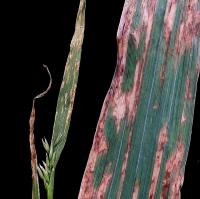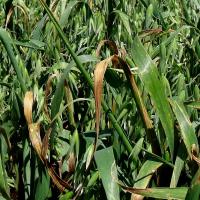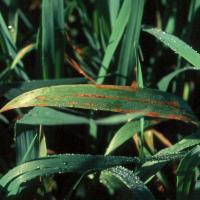Bacterial blight is most common in continuous oaten hay crops and is prevalent with extended periods of moist weather which facilitates splash of bacteria and provides suitable conditions for infection. The disease is favoured when crop density is high and there has been a high input of nitrogen making the plants soft. As the growing season progresses, plants generally grow away from this disease. Warm dry spring conditions will rapidly reduce spread of this disease.
Diagnosing stripe blight in oats
There are two types of bacterial disease which infect oat foliage; halo (Pseudomonas syringae pv. coronafaciens) and stripe (Pseudomonas syringae pv. striafaciens) blight.
What to look for
- Heavy infection leads to withering and death of leaves often from the tip.
- Diseased plants may occur in patches, and is worse in wetter areas and wet seasons.
- Vehicles may spread the disease by driving through wet infected plants.
- Water soaked then red-brown longitudinal stripes that often have narrow yellow margins. Stripes join into blotches that cause leaf collapse (blight).
- If the stripe occurs on the boot the florets inside may appear rotten and stained. emerged florets appear mottled brown to white and may be sterile.
What else could it be
| Condition | Similarities | Differences |
|---|---|---|
| Diagnosing halo blight in oats | Red-brown leaf lesions; worse in patches, wetter areas | Oval lesions surrounded by a paler halo, rather than longitudinal stripes |
Where did it come from?
- Blight bacteria survives on seed and crop debris.
- They are spread by rain-splash or leaf contact.
- Insects, particularly aphids, also spread blight bacteria.
Management strategies

Stubble management

Clean seed
- Unless infection is very severe, grain losses are insignificant, but hay quality is reduced.
- There is no chemical control for this disease (fungicides are not registered or effective against bacterial diseases).
- Avoid sowing into infected stubbles and burn or incorporate stubble if the problem is widespread.
- The disease can be seed borne, do not re-sow seed from infected crops.
- Avoid paddock operations when leaves are wet to prevent disease spread.
See also
Where to go for expert help
Page last updated: Friday, 19 February 2016 - 2:01pm





